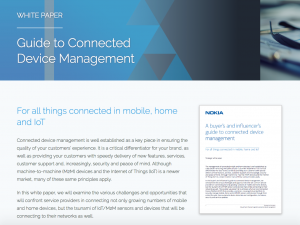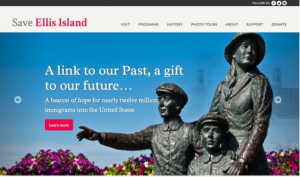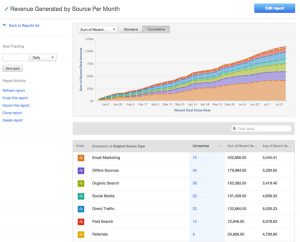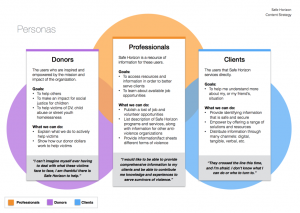
In the early days of business websites, it was enough to present a static “brochure” online: A quick overview of your business with contact information. But with today’s tools and technologies — like marketing automation, analytics platforms, and digital advertising — your website redesign can support or even sustain many core functions of your business.
 With targeted content and a consistent keyword strategy, we were able to break one B2B company into an entirely new IoT market.
With targeted content and a consistent keyword strategy, we were able to break one B2B company into an entirely new IoT market. The key is owning content marketing around topics in your market, then pushing to relevant audiences. Specifically, you may publish white papers, case studies, videos, or regular blog articles on your website. When targeted appropriately, these pieces will help expand your presence for qualified leads within search terms in your market.
Additionally, it’s vital to build a social media presence, and host thought pieces on third-party sites, connecting with thought leaders and growing your awareness beyond your own website:
When buyers are exposed to both search and social media messages from a company, their overall search click-through rate rose by 94%, according to GroupM.
Over time, you will earn backlinks to your website — building up your search engine authority for broad keywords and increasing your presence around the related web.
As an additional driver activity, amplify your reach with targeted driver campaigns like AdWords and paid social channels. 78% of marketers rely on Google Adwords and social media advertising to raise awareness of their brand, according to Formstack. With paid strategies, you can reach a broad or specific audience across several touchpoints, depending on your goals.
61% of survey respondents agreed that the winning vendor delivered a better mix of content appropriate for each stage of the purchasing process, according to a DemandGen report.
This statistic underscores why your company must provide value, insight, inspiration, and education during the buyer’s journey.
In order to educate, you must first understand your buyers. Specifically, where they’re searching, which answers they seek, and how they want to consume information. Therefore, you must conduct research to recognize your buyers’ pain points, opportunities, and challenges as they occur through the buying process.
 Your value proposition should be immediately clear and "above the fold" of your homepage.
Your value proposition should be immediately clear and "above the fold" of your homepage. In terms of delivery, you must understand which pages and paths on your website denote different buying stages. For example, is someone reading your blog ready for sales information? Probably not. And what kinds of questions do people have when they debate filling out a contact form? Can you resolve questions with a case study, video, or eBook?
Beyond education, you must find outlets to inspire your prospects. This starts with understanding the concerns, obligations, and opportunities of your buyer’s specific role. Then, you can craft videos, infographics, case studies, and strong value statements to spark inspiration. For example, if your IT buyer struggles to convince executives of technology investments, your value proposition could be: “An IT solution so impactful it sells itself to executives,” paired with real-world case studies and helpful spec sheets aimed at stakeholders.
With a full-funnel content strategy, your website design can help you become the preferred vendor for your prospects. And this is advantageous because 74% of buyers will prefer and remember the vendor who educates and inspires them early in the process, according to Corporate Insights.
At Ironpaper, we believe that companies must completely abandon cold calls and outbound sales — primarily because as a company, we ourselves rely 100% on digitally generated business. Therefore, we know firsthand the power of digital marketing to increase your lead pool and drive new business.
The return on outbound lead generation is dismal: In fact, 91% of B2B buyers never respond to an unsolicited inquiry, according to lead generation software reviews site Capterra.
 For the highest chance of providing ROI, measure metrics on goals that revolve around lead generation and conversion - not "vanity metrics" like bounce rate, time on page, social shares, etc.
For the highest chance of providing ROI, measure metrics on goals that revolve around lead generation and conversion - not "vanity metrics" like bounce rate, time on page, social shares, etc. That’s why permission-based lead conversion is so important for your website strategy. Inbound-generated leads respond more quickly, and also close into customers at a higher rate: In fact, SEO leads have a 14.6% close rate, while outbound leads (such as those acquired by cold calling, or print advertising) have a 1.7% close rate, according to Search Engine Journal.
So marketing and sales directors must rally around an inbound marketing plan for your website redesign. Specifically, both departments must collaborate on targeted content. Additionally, work together on a plan for continual optimization of conversion pages. And invest in a driver strategy that includes organic and paid channels.
Furthermore, a marketing automation tool can help you to identify leads on an individual level. Then, you can track which campaigns generate high-quality leads for your business. And, of course, you can scale up those channels wisely and increase your b2b lead generation over time.
Additionally, you can rely on your website to help with the sales process, both for lead nurturing and for up-selling. By driving back to your website content time and time again, you educate prospects and reinforce brand potency.
 Focus on your personas and their goals as you decide on content to nurture prospects through the sales cycle.
Focus on your personas and their goals as you decide on content to nurture prospects through the sales cycle. Your website is always available to answer questions, provide inspiration, and suggest a next step. This which greatly helps the sales process, when reps can’t be available 24/7. And according to Knowledge Tree, there may be 7-20 people involved in any given B2B purchasing decision. Therefore, your website can play an omnipresent role that’s easily shared amongst influencers.
Furthermore, if you facilitate many buying stages, you'll help nurture leads into customers on their own time. With self-driven research, your website acts as a guide for both education and decision. When partnered with an email nurturing strategy, you will drive more leads into enthusiastic customers by return visits to your website and content offers.
In fact, Demand Gen reports that companies excelling at lead nurturing generate 50% more sales leads at 33% lower cost per lead.
Moreover, educated leads translate to larger deal sizes. Nurtured leads make 47% larger purchases than non-nurtured leads, according to Protocol 80, Inc.
With strong business goals driving your website redesign, you'll achieve greater stakeholder buy-in and see greater results.
GroupM https://searchengineland.com/search-social-media-increases-ctr-by-94-percent-report-66231
Formstack https://www.formstack.com/report/lead-capture-2016
Corporate Insights https://win.corporatevisions.com/rs/corpv/images/CVI-%20CMO%20-Messaging-ebook_v6-interactive.pdf
Capterra https://blog.capterra.com/lead-gen-statistics-b2b-marketers-2015/
Knowledge Tree https://www.knowledgetree.com/blog/2015/08/what-do-todays-b2b-buyers-want/
Protocol 80, Inc. https://www.protocol80.com/blog/21-lead-nurturing-statistics-that-show-the-power-of-marketing-automation-and-workflows
by Jonathan Franchell, CEO of Ironpaper - For more tips and hacks: Need to remove a new line after h1 tags? Both web designers and SEO practitioners need to employ headline tags: H1, H2, H3 in several ways to improve web page structure and tag...

The Crowded Arena of the IT Marketplace Updated December 2024 The Information Technology (IT) landscape is experiencing rapid growth and intensifying competition. IT spending is projected to reach nearly 5.1 trillion U.S. dollars in 2024, a...

Updated December, 2024 The field of digital marketing is evolving rapidly in response to new technology and changing buyer expectations. To help career-minded marketers, we’ve rounded up the top 10 skills needed to succeed in the field. These are...
